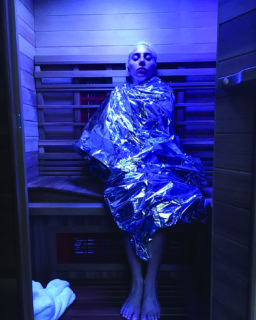She is one of the best-selling music artists in history. Lady Gaga (real name Stefani Germanotta) has sold 27 million albums. Forbes has also included her as one of its most powerful earners. But after years of mental and physical health issues, the 33-year-old star of A Star is Born took a step back from the limelight for a bit. Today, she has emerged as a stronger woman, opening up about living with PTSD and a debilitating chronic pain condition called fibromyalgia.
Overcoming bullies, sexual assault and misogynists
Lady Gaga made her breakthrough in the industry 11 years ago, becoming known as the Queen of Pop. An emotive artist, she has managed to channel her unique life experiences and difficulties through her music and reach out to fans who need to know they are not alone.
For Gaga, individuality is something to be appreciated and not derided. This was a lesson she learned after being subjected to years of cruel taunts growing up. Her drama-school peers went as far as creating a Facebook page called “Stefani Germanotta will Never Be Famous”.
Today, Lady Gaga is the only woman in the world to have won an Oscar, a Grammy, a BAFTA and a Golden Globe in the same year. Oh, – and nine Grammys throughout her career thus far.
The star recently admitted that her theatrical outfits serve a deep purpose too. They are a way to show control after being raped by an unknown music producer at the age of 19. Little is known about the assault, as Gaga is still trying to deal with the PTSD from which she suffers as a result. However, she explains that her bold fashion statements give her security. Especially in a business where sex sells and arrogance runs high among male producers, who dominate the industry.
“What I’ve done, if they wanted me to be sexier or if they wanted me to pop, [is] put some absurd spin on it that made me feel like I was still in control,” she says in her documentary, Gaga: Five Foot Two.
Lady Gaga is changing her tune
She attributes her PTSD to past assaults. However, her fibromyalgia diagnosis seems to be a result of both psychological trauma and further physical trauma she experienced in 2013 after she broke her hip.
After the injury, she couldn’t ignore the fact that her body was not recovering as it should. She was starting to experience her first relentless symptoms of this excruciating chronic pain condition.
“[You know] that fear and the drop in your stomach?” she says in an interview with Vogue. “My diaphragm seizes up. Then I have a hard time breathing, and my whole body goes into a spasm. And I began to cry. That’s what it feels like for trauma victims every day, and it’s… miserable….”
What is fibromyalgia?
Medical professionals are still trying to understand this baffling chronic pain condition. According to the US’s National Fibromyalgia Association, it affects between 3% and 6% of the http://www.fmaware.org/world’s population.
At this stage, what we do know about fibromyalgia is that:
1. It’s a disorder characterized by widespread musculoskeletal chronic pain.
2. It’s often triggered by trauma – usually physical, but it can be psychological.
3. It’s accompanied by other symptoms, such as fatigue, cognitive difficulties, headaches and migraines, sleep disorders, anxiety, and depression, or irritable bowel syndrome.
4. It’s different from “normal” pain. New research from the European Journal of Neuroscience indicates that people with fibromyalgia have an overly sensitized central nervous system that makes generally painless stimuli (such as tapping your shoulder or giving a strong handshake) excruciating for them.
5. It’s a condition that can be treated only symptomatically. There is no known cure or any guarantee that treatment will help.
6. It’s not directly fatal. However, it can lead to fatal issues, such as liver damage, or trigger psychiatric problems that lead to suicide.
7. It’s classified as an “invisible illness”, as pain is something you can only feel, not see. It’s hard to know if someone has fibromyalgia, as they look “normal” on the outside.
Keeping her health in check
Luckily, she has started to find an array of treatments that work for her and make it much easier to take on her daily life. 2019 is on the rise for this star.
“It’s getting better every day because now I have fantastic doctors who take care of me and are getting me show-ready,” she adds.
From what we can tell from her documentary and Instagram account, Lady Gaga uses a mixture of deep-tissue massage, muscular injections and sessions in her infra-red sauna to alleviate pain, muscle tightness, and inflammation.
However, each fibromyalgia case is different and needs to be treated differently too.
There are a variety of medications available, but the condition needs to be treated functionally in the long run.
Dr. Mary-Ann Fitzcharles, an associate professor of medicine in the Division of Rheumatology at McGill University in Canada, explains in an interview with Global News that self-management techniques such as proper sleep, minimized stress and healthy lifestyle choices are what most patients use to keep their symptoms under control.
“Probably the intervention that is most successful is a regular program of comfortable physical activity,” says Fitzcharles. “Non- pharmacological management is exceedingly important.”
For Lady Gaga, life is starting to fall into place. She is becoming more comfortable with who she is and proud of what she has accomplished.
“I’m just at a different time in my life now … I’m 30, and I feel better than ever! All my insecurities are gone… I never felt comfortable enough to just sing. I never felt pretty enough, or smart enough, or a good enough musician. And I do now. I know that of all the things I deserve, that is where I am worth something. So, I have to stay there – you know?” she shares in her documentary.
Is chronic pain keeping you awake at night? Then read this.
References:
- What is fibromyalgia? : http://www.fmaware.org/






![women [longevity live]](https://longevitylive.com/wp-content/uploads/2020/01/photo-of-women-walking-down-the-street-1116984-100x100.jpg)










